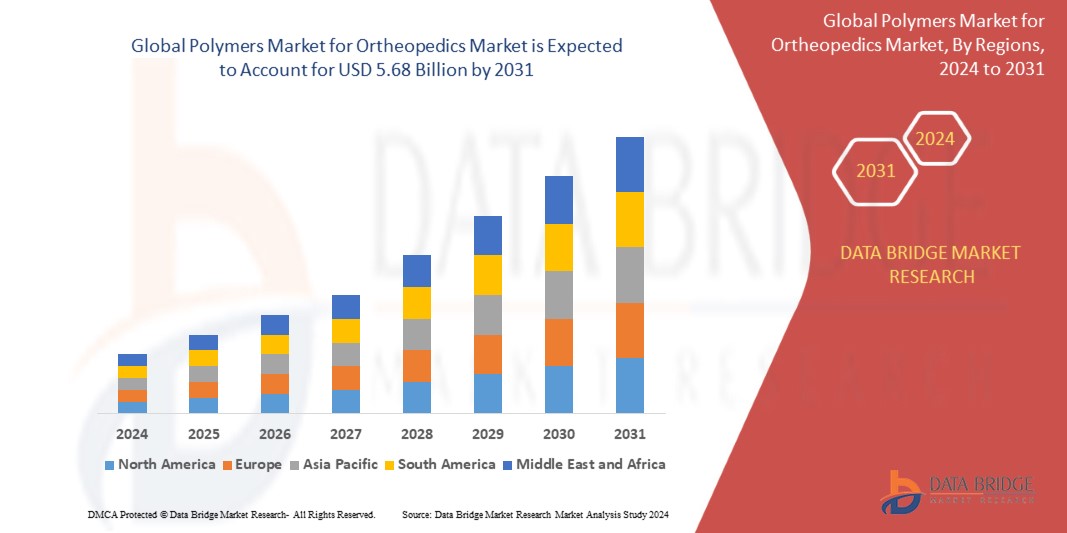整形外科用ポリマーの世界市場規模、シェア、トレンド分析レポート
Market Size in USD Billion
CAGR :
% 
| 2024 –2031 | |
| USD 3.67 Billion | |
| USD 5.68 Billion | |
|
|
|
整形外科用ポリマー市場の世界市場区分、ポリマー別(熱可塑性プラスチック、熱硬化性プラスチック、エラストマー)、用途別(関節置換、整形外科用デバイス、軟部組織修復、その他)、エンドユーザー別(病院、整形外科クリニック、リハビリテーションセンター、外来手術センター(ASC)) – 2031年までの業界動向と予測
整形外科用ポリマーの世界市場分析
整形外科におけるポリマーの応用は、患者の転帰を改善するために重要であり、その成長は材料科学、外科技術の進歩、および整形外科ソリューションの需要増加を反映しており、超高分子量ポリエチレン(UHMWPE)などのポリマーは、関節置換の寿命を延ばすために不可欠です。高齢化人口が増加し、変形性関節症の罹患率が増加するにつれて、股関節および膝関節インプラントの需要が高まっています。架橋UHMWPEなどのポリマー技術の進歩により、耐摩耗性が大幅に向上し、インプラントの故障リスクが軽減され、市場の成長に貢献し、市場を牽引しています。
整形外科用ポリマーの世界市場規模
整形外科用ポリマーの世界市場規模は、2023年に36億7,000万米ドルと評価され、2024年から2031年の予測期間中に5.6%のCAGRで成長し、2031年までに56億8,000万米ドルに達すると予測されています。市場価値、成長率、セグメンテーション、地理的範囲、主要プレーヤーなどの市場シナリオに関する洞察に加えて、Data Bridge Market Researchがまとめた市場レポートには、輸出入分析、生産能力概要、生産消費分析、価格動向分析、気候変動シナリオ、サプライチェーン分析、バリューチェーン分析、原材料/消耗品概要、ベンダー選択基準、PESTLE分析、ポーター分析、規制枠組みも含まれています。
整形外科用ポリマーの世界市場動向
「ポリマー技術の進歩」
ポリマー化学と材料科学の革新により、耐摩耗性、生体適合性、強度などの特性が向上した高度なポリマーが開発されました。これらの進歩により、ポリマーはインプラント、固定装置、軟部組織修復など、さまざまな整形外科用途にますます適したものになっています。架橋 UHMWPE や生分解性ポリマーなどの新しいポリマー配合により、整形外科用デバイスの性能と寿命が向上します。これらの材料は臨床結果が優れているため、臨床現場で採用される可能性が高くなります。3D 印刷技術の台頭により、個々の患者の解剖学的構造に合わせてポリマーベースのインプラントをカスタマイズできるようになりました。この機能により、整形外科ソリューションの有効性が高まり、その広範な使用が促進されます。
レポートの範囲と整形外科用ポリマーの世界市場 市場セグメンテーション
|
レポートメトリック |
整形外科用ポリマーの世界市場 市場洞察 |
|
対象セグメント |
|
|
対象国 |
米国、カナダ、メキシコ、ドイツ、フランス、英国、オランダ、スイス、ベルギー、ロシア、イタリア、スペイン、トルコ、その他のヨーロッパ諸国、中国、日本、インド、韓国、シンガポール、マレーシア、オーストラリア、タイ、インドネシア、フィリピン、その他のアジア太平洋諸国、サウジアラビア、UAE、南アフリカ、エジプト、イスラエル、その他の中東およびアフリカ諸国、ブラジル、アルゼンチン、その他の南米諸国 |
|
主要な市場プレーヤー |
DePuy Synthes, Inc. (米国)、Stryker Corporation (米国)、Zimmer Biomet (ドイツ)、Medtronic, Inc. (米国)、Smith+Nephew. (英国)、B. Braun SE (ドイツ)、NuVasive, Inc. (米国)、Orthofix Medical Inc. (米国)、Aesculap AG (ドイツ)、およびExactech, Inc. (米国) |
|
市場機会 |
|
|
付加価値データ情報セット |
Data Bridge Market Research がまとめた市場レポートには、市場価値、成長率、セグメンテーション、地理的範囲、主要プレーヤーなどの市場シナリオに関する洞察に加えて、輸出入分析、生産能力の概要、生産消費分析、価格動向分析、気候変動シナリオ、サプライ チェーン分析、バリュー チェーン分析、原材料/消耗品の概要、ベンダー選択基準、PESTLE 分析、ポーター分析、規制枠組みも含まれています。 |
整形外科用ポリマーの世界市場 市場定義
整形外科用ポリマーとは、インプラント、固定器具、人工装具、手術器具など、整形外科用途に特化して設計された合成高分子または天然高分子の一種を指します。これらのポリマーは、生体適合性、機械的強度、柔軟性、耐久性などの独自の特性に基づいて選択または設計されており、生物組織や体液との相互作用に適しています。
整形外科用ポリマーの世界市場動向
ドライバー
- 高齢化と筋骨格系疾患の増加
世界の人口は高齢化しており、変形性関節症、骨粗鬆症、変形性関節症などの加齢に伴う筋骨格障害の発生率が高まっています。この人口動態の変化により、関節置換術やポリマーベースのインプラントやデバイスを使用するその他の手術を含む整形外科手術の需要が高まっています。関節置換術を必要とする人が増えるにつれて、UHMWPE などの耐久性と生体適合性を備えた材料の必要性が高まります。この傾向により、関節形成術におけるポリマーの需要が大幅に増加すると予想されます。
- 低侵襲手術法への関心が高まる
整形外科では、患者の回復期間の短縮、術後の痛みの軽減、合併症のリスクの低減を実現する低侵襲手術 (MIS) 技術への傾向が高まっています。ポリマーは、軽量で柔軟性があり、生体適合性のある材料を提供することで、これらの技術を促進する上で重要な役割を果たします。生体吸収性固定装置や軽量副木など、MIS をサポートする高度なポリマーベースのデバイスの需要が高まっています。外科医と患者がこれらの技術を好むため、関連するポリマー製品の市場は拡大すると予想されます。
機会
- 生体吸収性ポリマーの開発
生体吸収性ポリマーは、インプラントを除去するための二次手術の必要性をなくすため、その需要が高まっています。これらの材料は体内で徐々に溶解し、治癒過程をサポートし、組織の統合を促進します。外科医と患者が侵襲性の低い選択肢を求めているため、生体吸収性固定器具 (ネジ、プレートなど) の市場は大幅に成長する見込みです。これにより、メーカーは特定の整形外科用途に合わせて新しい生体吸収性製品を革新し、開発する機会が得られます。
- 革新的な薬物送達システム
整形外科用薬物送達システムにおけるポリマーの使用は、治癒プロセスを強化する大きな機会を提供します。ポリマーは、治療薬を局所的に放出するように設計でき、骨の成長を促進したり、手術部位の周囲の炎症を軽減したりできます。整形外科用機器メーカーは、製薬会社と提携して、ポリマーと生物製剤または医薬品を統合した革新的な薬物送達システムを開発できます。このコラボレーションにより、包括的な治療ソリューションが生まれます。
制約/課題
- 規制上のハードル
整形外科分野は規制が厳しく、新しいポリマー材料や製品には広範なテストと承認プロセスが必要です。FDA (米国食品医薬品局) や EMA (欧州医薬品庁) などの規制機関は、安全性と有効性を確保するために厳格なガイドラインを課しています。製品開発と規制承認に要する時間は膨大で、革新的な製品の市場参入が遅れることがよくあります。企業は、生体適合性、機械的性能、長期安定性に関する厳格なテスト要件を満たすという課題に直面する可能性があります。
- 材料の制限とパフォーマンスの問題
ポリマーには多くの利点がありますが、金属などの従来の材料と比較すると、機械的特性、耐久性、長期的性能に関して制限もあります。ポリマーは、特に関節置換などの高ストレス用途では、時間の経過とともに摩耗する傾向があります。ポリマー部品が、体内で発生する機械的負荷と繰り返しのストレスに耐えられるようにすることが重要です。生体吸収性ポリマーの場合、治癒中の適切なサポートと制御された分解のバランスをとることが難しい場合があります。ポリマーの分解が速すぎたり遅すぎたりすると、構造サポートの不足や炎症反応などの合併症を引き起こす可能性があります。
この市場レポートでは、最近の新しい開発、貿易規制、輸出入分析、生産分析、バリュー チェーンの最適化、市場シェア、国内および現地の市場プレーヤーの影響、新たな収益源の観点から見た機会の分析、市場規制の変更、戦略的市場成長分析、市場規模、カテゴリ市場の成長、アプリケーションのニッチと優位性、製品の承認、製品の発売、地理的拡大、市場における技術革新などの詳細が提供されます。市場に関する詳細情報を取得するには、アナリスト ブリーフについて Data Bridge Market Research にお問い合わせください。当社のチームが、情報に基づいた市場決定を行い、市場の成長を実現できるようお手伝いします。
原材料不足と出荷遅延の影響と現在の市場シナリオ
Data Bridge Market Research は、市場の高水準な分析を提供し、原材料不足や出荷遅延の影響と現在の市場環境を考慮した情報を提供します。これは、戦略的な可能性を評価し、効果的な行動計画を作成し、企業が重要な決定を下すのを支援することにつながります。
標準レポートの他に、予測される出荷遅延からの調達レベルの詳細な分析、地域別の販売代理店マッピング、商品分析、生産分析、価格マッピングの傾向、調達、カテゴリパフォーマンス分析、サプライチェーンリスク管理ソリューション、高度なベンチマーク、その他の調達および戦略サポートのサービスも提供しています。
経済減速が製品の価格と入手可能性に及ぼす予想される影響
経済活動が減速すると、業界は打撃を受け始めます。DBMR が提供する市場洞察レポートとインテリジェンス サービスでは、景気後退が製品の価格設定と入手しやすさに及ぼす予測される影響が考慮されています。これにより、当社のクライアントは通常、競合他社より一歩先を行き、売上と収益を予測し、損益支出を見積もることができます。
最近の開発
- 2024年4月、ニューヨークに拠点を置くポリマーメディカルは、人口動態の変化と遠隔医療市場に根ざしたビジネスチャンスを見出しているプラスチック業界のベテラン2人によって率いられています。
- 2024年4月、プラスチック業界のベテランであるベンジャミン・ハープとトム・リビッキは、医療およびバイオサイエンスの顧客に契約射出成形および組み立てサービスを提供するポリマーメディカル社を設立しました。新会社は、重要な薬物送達システム、注射器などの医療用使い捨て製品、在宅医療から整形外科までのための医療機器の製造に重点を置きます。
整形外科用ポリマーの世界市場 市場範囲
市場はポリマー、アプリケーション、最終用途に基づいてセグメント化されています。これらのセグメントの成長は、業界のわずかな成長セグメントを分析するのに役立ち、ユーザーに貴重な市場の概要と市場の洞察を提供し、コア市場アプリケーションを特定するための戦略的決定を下すのに役立ちます。
ポリマー
- 熱可塑性プラスチック
- 熱硬化性プラスチック
- エラストマー
- シリコーン
- ポリウレタンエラストマー
- 熱可塑性エラストマー(TPE)
応用
最終用途
- 病院
- 整形外科クリニック
- リハビリテーションセンター
- 外来手術センター(ASC)
整形外科用ポリマーの世界市場 市場地域分析
市場は分析され、市場規模の洞察と傾向は、上記のように国、ポリマー、アプリケーション、および最終用途別に提供されます。
市場に含まれる国は、米国、カナダ、メキシコ、ドイツ、フランス、英国、オランダ、スイス、ベルギー、ロシア、イタリア、スペイン、トルコ、その他のヨーロッパ諸国、中国、日本、インド、韓国、シンガポール、マレーシア、オーストラリア、タイ、インドネシア、フィリピン、その他のアジア太平洋諸国、サウジアラビア、UAE、南アフリカ、エジプト、イスラエル、その他の中東およびアフリカ諸国、ブラジル、アルゼンチン、その他の南米諸国です。
北米は、高度な医療技術にアクセスできる高度に発達した医療システムを備えているため、最も急速に成長しています。このインフラストラクチャは、ポリマーベースの製品を含む革新的な整形外科ソリューションの広範な研究、開発、導入をサポートしています。
アジア太平洋地域は、人口の高齢化とライフスタイル要因により、変形性関節症や骨折などの整形外科疾患の罹患率がアジア太平洋地域で著しく、最も高い CAGR を記録しています。これにより、整形外科手術と関連製品に対する需要が高まり、ポリマー市場の成長を牽引しています。
レポートの国別セクションでは、市場の現在および将来の傾向に影響を与える国内市場における個別の市場影響要因と規制の変更も提供しています。下流および上流のバリュー チェーン分析、技術動向、ポーターの 5 つの力の分析、ケース スタディなどのデータ ポイントは、個々の国の市場シナリオを予測するために使用される指標の一部です。また、国別データの予測分析を提供する際には、グローバル ブランドの存在と可用性、および地元および国内ブランドとの競争が激しいか少ないために直面する課題、国内関税と貿易ルートの影響も考慮されます。
整形外科用ポリマーの世界市場シェア
市場競争環境では、競合他社ごとの詳細が提供されます。詳細には、会社概要、会社の財務状況、収益、市場の可能性、研究開発への投資、新しい市場への取り組み、世界的なプレゼンス、生産拠点と施設、生産能力、会社の強みと弱み、製品の発売、製品の幅と広さ、アプリケーションの優位性などが含まれます。提供される上記のデータ ポイントは、市場に関連する会社の焦点にのみ関連しています。
整形外科用ポリマーの世界市場において、市場で事業を展開している市場リーダーは次のとおりです。
- デピューシンセス社(米国)
- ストライカーコーポレーション(米国
- ジマー・バイオメット(ドイツ)
- メドトロニック社(米国)
- スミス・ネフュー(英国)
- B.ブラウンSE(ドイツ)
- NuVasive, Inc.(米国
- オーソフィックスメディカル社(米国)
- エースクラップAG(ドイツ)
- Exactech, Inc.(米国)
SKU-
世界初のマーケットインテリジェンスクラウドに関するレポートにオンラインでアクセスする
- インタラクティブなデータ分析ダッシュボード
- 成長の可能性が高い機会のための企業分析ダッシュボード
- カスタマイズとクエリのためのリサーチアナリストアクセス
- インタラクティブなダッシュボードによる競合分析
- 最新ニュース、更新情報、トレンド分析
- 包括的な競合追跡のためのベンチマーク分析のパワーを活用
調査方法
データ収集と基準年分析は、大規模なサンプル サイズのデータ収集モジュールを使用して行われます。この段階では、さまざまなソースと戦略を通じて市場情報または関連データを取得します。過去に取得したすべてのデータを事前に調査および計画することも含まれます。また、さまざまな情報ソース間で見られる情報の不一致の調査も含まれます。市場データは、市場統計モデルと一貫性モデルを使用して分析および推定されます。また、市場シェア分析と主要トレンド分析は、市場レポートの主要な成功要因です。詳細については、アナリストへの電話をリクエストするか、お問い合わせをドロップダウンしてください。
DBMR 調査チームが使用する主要な調査方法は、データ マイニング、データ変数が市場に与える影響の分析、および一次 (業界の専門家) 検証を含むデータ三角測量です。データ モデルには、ベンダー ポジショニング グリッド、市場タイムライン分析、市場概要とガイド、企業ポジショニング グリッド、特許分析、価格分析、企業市場シェア分析、測定基準、グローバルと地域、ベンダー シェア分析が含まれます。調査方法について詳しくは、お問い合わせフォームから当社の業界専門家にご相談ください。
カスタマイズ可能
Data Bridge Market Research は、高度な形成的調査のリーダーです。当社は、既存および新規のお客様に、お客様の目標に合致し、それに適したデータと分析を提供することに誇りを持っています。レポートは、対象ブランドの価格動向分析、追加国の市場理解 (国のリストをお問い合わせください)、臨床試験結果データ、文献レビュー、リファービッシュ市場および製品ベース分析を含めるようにカスタマイズできます。対象競合他社の市場分析は、技術ベースの分析から市場ポートフォリオ戦略まで分析できます。必要な競合他社のデータを、必要な形式とデータ スタイルでいくつでも追加できます。当社のアナリスト チームは、粗い生の Excel ファイル ピボット テーブル (ファクト ブック) でデータを提供したり、レポートで利用可能なデータ セットからプレゼンテーションを作成するお手伝いをしたりすることもできます。





